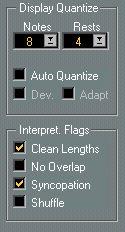Display Quantize and Interpretation Flags

These two sections of the dialog contain a number of settings used to determine how the notes should be interpreted. While these settings are more critical to making MIDI recorded music appear as legible as possible it is still important to have them set correctly when entering notes using the mouse. Below you will find a brief summary of the settings - for more details, see page 70.
Notes and Rests Quantize values
• Generally, the Note Quantize value should be set to a value equal to, or smaller than, the “smallest note position” you want to be shown in the score.
• The Rest Quantize value should be set to a value equal to, or smaller than, the smallest note value (length) you want to be displayed for a single note, positioned on a beat.
• If the score contains only triplets, or mostly triplets, select one of the Triplet options.
Auto
• If the piece contains no triplets or only triplets, deactivate this option.
• If the piece contains mixed triplets and straight notes, activate this option (the additional options are described in detail on page 71).
Interpretation Flags
Activate This:
Clean Lengths
No Overlap
Syncopation Shuffle When:
When you find the program generally interprets your notes as shorter than you expect. See page 71.
When notes starting at the same position, but having different lengths, give you more ties than you want. See page 72.
When the program adds more ties to notes crossing beats and bar lines than you prefer. See page 72.
When you have played a shuffle beat and want it displayed as straight notes (no triplets). For details see page 73.




